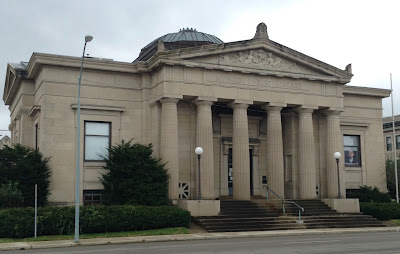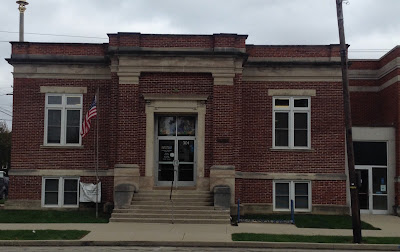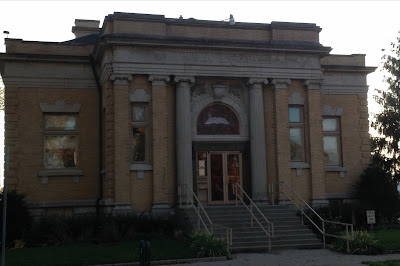I didn't have to go hunting for a laundromat after my cold, rain-drenched night of camping to dry my gear, as the temperature sky-rocketed twenty degrees to sixty the next day and there was even a couple hour window in the afternoon of sunshine. I draped my sleeping bag over my bike while I was in one library and used the handlebars as a clothes line for socks and other garb.
Well before nightfall thick, grey, ominous clouds moved back in and so low in the sky rain seemed imminent again. Even though it was nearly an hour until dark I was taking no chances of getting soaked again, so when I came upon a forest with a cable across an entry point, that was my gateway to a quiet, secluded campsite. I unhesitatingly slipped around the barrier and pushed deep into the wooded sanctuary, grateful for the luxury of a trail, not having to wend my way over and around fallen trees and prickly bushes as is the customary wild camping procedure.
The temperature remained close to sixty, so for the first time in days I didn't have to put on my wool cap and pull the hood of my sweat shirt over my head or drape my sleeping bag over my legs and add a couple more layers to my torso as I sat and read and ate. I could lean back in my campchair with nary a worry in the world. The only sound was a golf ball-sized walnut dropping once or twice. Indiana could well be called the Walnut State, they are so ubiquitous. Towns recognize their prominence, frequently naming one of their main streets Walnut. Three Carnegie Libraries in the state are on a Walnut Street. Main Street is by far the most popular address for a Carnegie, with thirty-five. Otherwise, only Washington Street with five, registers more times than Walnut. Presidents are more popular than trees with Jefferson, Jackson, Madison and Van Buren, and only by coincidence, Clinton. Maple, Poplar and Locust are the other tree-named streets with a Carnegie
The Carnegie in the large city of Muncie on Jackson Street was very presidential and almost pompous with six grand columns and the Latin inscription "bvilt anno dominin 1902" just below "This building the gift of Andrew Carnegie" with "Law Science Prose" to one side and "Art Poetry Mvsic" to the other.
One had to go around the back to enter. It is now a research library, primarily genealogy, and only open three days a week. The city's two branch libraries have regular hours and are in the lending business. The city's largest bike store was just down the street. My front tire is wearing thin, but since it didn't have the heavy-duty touring tire I prefer in stock, I passed on their lighter-weight racing tires, trusting my tire had two hundred miles left in it, about what I have left to ride before returning home. I had replaced the rear tire a month ago in Bloomington before the Hilly Hundred. No flats though in over 3,000 miles. The only mechanical has been breaking a rear derailleur cable, easily replaced on the spot.
From Muncie I headed north to a cluster of six towns with Carnegies in the heart of the Indiana Gas Boom of 1887, where the largest deposit of natural gas until then was discovered along with the first giant oil reserve in the country. The gas was found by coal miners, who at first didn't realize what it was. The boom didn't last much more than two decades, but the soil was so agriculturally rich, the region continued to thrive.
The still vibrant Gas City, with a huge Walmart distribution center on one side of the city and a large Dollar Store distribution center on another, pays tribute to its heritage with streets signs mounted on top of mini-oil derricks for over a mile on its Main Street and also out front of its Carnegie on Main Street. It had an addition to its side. Among the messages flashed on its message board out front was "Libraries lift lives."
Marion, on the Mississinewa River, one letter longer than Mississippi, is the largest city in the area and had earned a $50,000 grant for its Carnegie, as had Muncie and Anderson. Their architect rendered a bland, uninspired design, especially compared to the spectacular beauty of the other two. The best part of the library is the contents of the museum that now resides within it. The new library is attached to its backside, where one enters both the library and the museum devoted to the history of the region.
A sign on the door and a sign on the circulation desk offered locks to bicyclists, implying this was a city caught between small-town and big-town sensibilities. "Pvblic Library" was spelled out in puny letters over the entry to the original library, while high above in much larger lettering was "Art Literatvre Mvsic" with the old style "v" rather than "u."
The Van Buren Carnegie is an unaltered basic red brick model identified with a simple, but bold "Library" on its facade. It distinguished itself with the grave out front of a cat that had abided in it for years.
The Converse Carnegie is also in "As Was" condition, so much so that a sign out front with the wheelchair emblem on it offered a phone number to call if one needed help to use the facility. Plaques on either side of the entry state the library was built on the site of the first house in Converse in 1847 and that the library is on the National Register of Historic Places.
Montpelier, like Gas City and Muncie, had a speedway on its outskirts. Indiana with its world-famous speedway in Indianapolis could just as easily be known as the Speedway State or the Walnut State, rather than the Hoosier State. The Montpelier Carnegie was another unaltered large single room library with high ceilings, solid wood tables and book shelves and circulation desk that took one back in time.
The local church had posted a notice on the bulletin board offering free bread on Thursdays from 3:30 to 5. The town bank had the distinction of having been robbed by John Dillinger in 1933, a year before he was gunned down by federal agents outside the Biograph Theater in Chicago at the age of 31.
The distinguished Hartford City Carnegie had an addition hidden from those entering its front door to its backside. It's front had the extra ornamentation of a pair of bundles of grains and an open book in its stained glass window. A sign on the elevator door in the addition read, "You must be 18 or have a disability to use."
It maintained a small memorial to Carnegie with his portrait over a fireplace flanked by flags. The mantle contained two framed postcards of the library dating to its opening and several leather-bound books. One could sit in a padded chair with a book-designed fabric and put one's legs up a matching footstool such as should be standard issue in all libraries. It was hard to part from such comfort. I was surprised they were unoccupied.
There are another dozen Carnegies in the northeast corner of the state awaiting me, but I'll save them for an Illinois-style completion of all the Carnegies that have eluded me along the eastern border of the state down to the Ohio River. That will make a fine three-week ride as I just completed in Illinois. Now is the time to end this two-month ride that began in Telluride and ended up being twice as long as I thought it would be, making it all the more glorious.










No comments:
Post a Comment